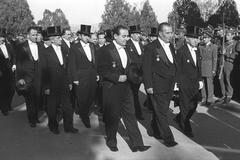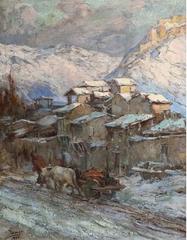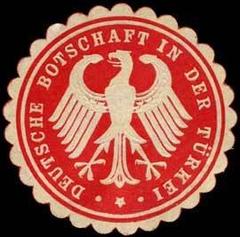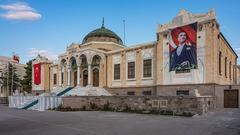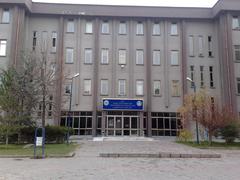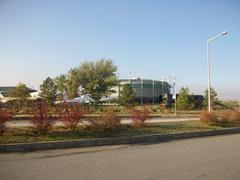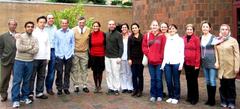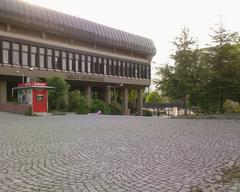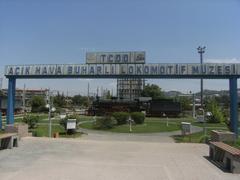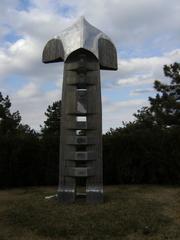Ankara Synagogue: Visiting Hours, Tickets, and Historical Sites Guide
Date: 04/07/2025
Introduction
The Ankara Synagogue, located in the historic Ulus district of Turkey’s capital, is the last remaining active synagogue in the city and an enduring symbol of Ankara’s multicultural legacy. As a testament to centuries of Jewish presence in Anatolia, the synagogue not only embodies religious resilience but also highlights the city’s rich, pluralistic history—from the Ottoman era to the present day. This detailed guide provides in-depth information on the synagogue’s history, cultural significance, practical visiting details, and nearby attractions, ensuring visitors can respectfully and meaningfully engage with this remarkable site (belleten.gov.tr, middleeasteye.net, ajammc.com, turkishminute.com).
Historical Overview
Early Jewish Presence in Ankara
Jewish life in Ankara dates back to antiquity, with sources suggesting a community existed as early as the 2nd century BCE (belleten.gov.tr). During the Roman and Ottoman periods, Ankara’s Jews formed a small but stable community, coexisting alongside Greeks, Armenians, and Muslims in a diverse urban environment.
Sephardic Influence and Community Growth
The expulsions of Jews from Spain (1492) and Portugal (1497) brought a significant influx of Sephardic Jews to Anatolia. Many joined the Romaniote Jews already in Ankara, boosting the community’s size and influence. This period saw a flourishing of Jewish culture, commerce, and religious life, with the community playing a notable role in the city’s textile trade (middleeasteye.net, turkishminute.com).
The Jewish Quarter (Yahudi Mahallesi)
The Jewish quarter, known as “Yahudi Mahallesi,” was situated below Samanpazarı, featuring narrow streets and two-story homes with inner courtyards. Synagogues and mosques stood side by side, reflecting a spirit of coexistence (belleten.gov.tr, salom.com.tr). Although much of the district has suffered from neglect and redevelopment, its history endures in the surviving synagogue.
Ankara Synagogue: History, Architecture, and Community Life
Architectural Features
The current Ankara Synagogue was constructed in 1834 in stone, replacing older structures, and significantly refurbished in 1906 by an Italian architect (kulturenvanteri.com, wikipedia.org). Its rectangular plan, floral motifs, and Old Testament symbolism—such as the three steps leading to the Ark (Ehal) and a bimah (Teva) reminiscent of Noah’s Ark—reflect both Anatolian and European influences (touristplatform.com). The interior is noted for its ornate woodwork, Turkish-style rugs, and stained glass windows, creating a warm and dignified atmosphere (ajammc.com).
Community Life and Decline
Historically, the synagogue served as the hub of Jewish religious, educational, and charitable activities. With Ankara’s designation as Turkey’s capital in 1923, urbanization and migration led to a gradual decline in the Jewish population. By the mid-20th century, only a handful of families remained, and today, the community numbers just a few dozen (turkishminute.com). Nevertheless, the synagogue continues to host religious services during major festivals and special events, maintaining its role as a vital center for Jewish life (wikipedia.org).
Visiting Ankara Synagogue: Practical Information
Visiting Hours
The synagogue does not have fixed public visiting hours and is generally open only during major Jewish festivals (such as Yom Kippur and Sukkot) or by prior arrangement (ajammc.com). To visit, contact the Ankara Jewish community or coordinate through a cultural tourism agency several weeks in advance.
Tickets and Admission
There are no entrance fees or public ticketing systems. Visits are free, but donations to support the synagogue’s upkeep are appreciated.
Accessibility
Located in the historic Ulus district, the synagogue is accessible via Ankara’s Metro (Ulus station) and public buses. However, the surrounding streets are often steep and cobblestoned, and the synagogue itself has stairs, which may limit access for visitors with mobility challenges. Contact the synagogue in advance to discuss accommodations (Tripcrafters).
Dress Code and Visitor Etiquette
- Men: Wear long trousers and sleeves; head coverings (kippah) are required and often available at the entrance.
- Women: Wear skirts or dresses below the knee, cover shoulders, and avoid sleeveless or low-cut tops. A scarf is recommended (Messianic Hebrews).
- General: Dress modestly, avoid loud conversation, and maintain respectful behavior.
- Photography: Usually prohibited, especially during services. Always ask permission.
Security
Due to security concerns, expect ID checks and bag inspections. Only visitors with prior appointments or valid reasons for visiting are admitted. Arrive early to accommodate security procedures.
Guided Tours and Special Events
Occasional guided tours are arranged through local Jewish organizations or cultural tour agencies, providing deeper insight into the synagogue’s history and Ankara’s Jewish legacy. During major Jewish holidays, the synagogue hosts special events which may be open to visitors by invitation (Salom).
Nearby Attractions
Enhance your visit by exploring these sites in the Ulus district:
- Ankara Castle: Historic fortress with panoramic city views.
- Museum of Anatolian Civilizations: Renowned collection of archaeological artifacts.
- Roman Baths: Remnants of Ankara’s Roman past.
- Hacı Bayram Mosque: Iconic Ottoman-era mosque.
- Çıkrıkçılar Yokuşu Bazaar: Traditional markets for souvenirs and local crafts.
Combining a visit to the synagogue with these attractions offers a comprehensive experience of Ankara’s historical layers (Tripcrafters).
Preservation Efforts and Digital Heritage
Preservation of the Ankara Synagogue and remaining Jewish quarter faces challenges from urban redevelopment and limited resources. Digital initiatives, such as the “Jewish Quarter Ankara Digital Platform,” document and share this heritage with global audiences, supporting cultural memory and awareness (middleeasteye.net).
Rituals, Language, and Community Identity
Ladino, the Judeo-Spanish language of Sephardic Jews, was once spoken in the synagogue and community, but is now nearly extinct in Ankara. Ceremonies and music reflect a blend of Ottoman, Sephardic, and Turkish influences, while cultural programs help transmit this unique heritage (ajammc.com, Salom).
Frequently Asked Questions (FAQ)
Q: What are the Ankara Synagogue visiting hours?
A: The synagogue is open during major Jewish holidays or by prior arrangement. Contact the Ankara Jewish community or a cultural tourism agency to schedule a visit.
Q: Is there an entrance fee or ticket?
A: No tickets are required; visits are free. Donations for maintenance are appreciated.
Q: Can tourists attend religious services?
A: Yes, with advance permission. Inquire ahead about service times and attendance.
Q: Is the synagogue accessible for visitors with disabilities?
A: Accessibility is limited due to the historic building and surrounding terrain. Contact in advance for accommodations.
Q: Is photography allowed?
A: Generally not permitted inside, especially during services. Always seek permission.
Q: What is the dress code?
A: Modest dress is required; men must cover their heads, and women should cover shoulders and wear skirts or dresses below the knee.
Recommendations for Visitors
- Plan in Advance: Arrange visits well ahead of time and confirm details with community representatives.
- Respect the Space: The synagogue is an active house of worship; maintain a respectful demeanor and follow dress codes.
- Combine with Other Sites: Explore the surrounding Ulus district for a richer cultural experience.
- Support Preservation: Consider making a donation to help maintain this important heritage site.
Conclusion
The Ankara Synagogue is a living monument to the resilience of Ankara’s Jewish community and a vital symbol of the city’s multicultural heritage. While the community has greatly diminished, the synagogue continues to serve as a center for worship, memory, and intercultural understanding. Visiting this sacred site—when done thoughtfully and respectfully—offers unique insights into Ankara’s pluralistic history and the enduring legacy of its Jewish residents.
For further updates on visiting hours, special events, and cultural sites in Ankara, download the Audiala app, explore our related articles, and follow us on social media.
